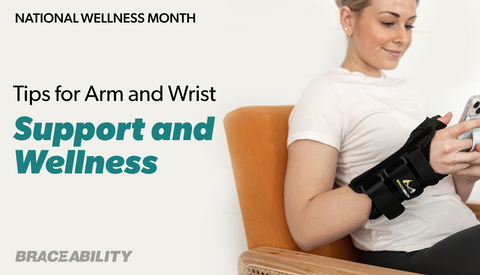Hand & Wrist Arthritis
What Is Hand and Wrist Arthritis, and How Does It Result in Arthritis Hand Pain?
Arthritis is a common ailment that afflicts millions of people worldwide. In a nutshell, arthritis is an inflammation of the joints. In fact, literally, the word “arthritis” means “inflamed joint.” Commonly, a joint is made up of two smooth, cartilage-covered bones that are attached together as a set. Normal joints move smoothly against each other unless a disorder or condition disrupts this smooth movement. Arthritis occurs when these two smooth surfaces tend to become irregular and no longer fit together as they would, like hand to glove. The result is a wearing out of the joints, and in the specific case of hand and wrist arthritis, arthritis hand pain and arthritis wrist pain occurs.
There are actually two types of arthritis that afflict the hand and wrist: rheumatoid arthritis and osteoarthritis, which is also commonly known as degenerative arthritis.
What You Should Know about Rheumatoid Arthritis Hand Pain
Rheumatoid arthritis wrist pain is commonly caused by rheumatoid arthritis, a common disorder of the synovium. The synovium, also known as the synovial membrane or stratum synovial, is the soft tissue that lines and nourishes joints and tendons throughout the human body. What you need to know is that rheumatoid arthritis is an autoimmune disease. What this means, and what happens, is that the body attacks its own tissues—in this specific instance, the joints. In other words, in rheumatoid arthritis, the defenses that are supposed to protect the body from infection instead damage the joints, cartilage, and ligaments. In extreme cases, rheumatoid arthritis can even soften the bones. (It is thought that rheumatoid arthritis can even cause trigger finger.)
Rheumatoid arthritis, which is a chronic disease, actually starts in the smaller joints like those found in the hand and wrist. When the white blood cells travel to the synovium of the hand or wrist, the synovium is inflamed. This causes warmth, redness, swelling, and rheumatoid arthritis hand pain. During inflammation caused by rheumatoid arthritis in the hand and wrist, the synovium becomes thicker, and as a result, the joint becomes puffy and swollen. Needless to say, when rheumatoid arthritis of the hand and wrist progresses, the abnormal synovial cells tend to invade and erode the cartilage as well as the bone within the joint. As a result, rheumatoid arthritis hand pain and rheumatoid arthritis wrist pain becomes more severe.
Until now it is unclear what exactly causes rheumatoid arthritis, although medical experts and doctors suspect that it may be hereditary, which means some people are more susceptible or predisposed to the disease based on their genetics. Other doctors and medical experts, however, believe that there are certain environmental or chemical triggers that activate the disease in people who are genetically predisposed or susceptible to inherit rheumatoid arthritis.
Arthritis Pain in Wrist and Hand Caused by Osteoarthritis
Osteoarthritis of the wrist differs from rheumatoid arthritis in that the former is a progressive and degenerative disease that eventually destroys the smooth articular cartilage that covers the ends of the bones. While healthy joints can move easily because of the articular cartilage, osteoarthritis causes this cartilage to wear or strip away, and because of this, bare bones rub against each other. This causes arthritis hand pain and arthritis wrist pain.
Osteoarthritis may actually be caused by simple wear and tear on the joints, or it can also develop after an injury to the joint (common wrist and thumb injuries include carpal tunnel syndrome and trigger thumb). In osteoarthritis of the wrist and hand, osteoarthritis most often occurs in three locations: at the base of the thumb, where the thumb and wrist come together (which causes arthritis thumb pain); at the end joint that is closest to the fingertip; and at the middle joint of a finger. However, the most common site of osteoarthritis in the hand is the wrist, which causes arthritis wrist pain.
While stiffness, swelling, and arthritis hand pain are common symptoms associated with both types of arthritis in the hand and wrist, there are several symptoms specifically associated with osteoarthritis: bony nodules that develop at the middle joint of the finger; a deep, aching pain in the base of the thumb that's also commonly known as arthritis thumb pain; a swelling and bump at the base of the thumb where it joins the wrist; and diminished grip and pinch strength in the affected area.
While there is actually no cure for both osteoarthritis and rheumatoid arthritis, there are a number of treatments and remedies that can provide arthritis hand pain relief.
How to Achieve Hand Arthritis Pain Relief
So how can someone who is suffering from rheumatoid arthritis and osteoarthritis of the hand/wrist achieve arthritis wrist pain relief?
When treating arthritis of the hand and wrist, one should aim to restore function to the afflicted area while relieving pain at the same time. This is achieved by a combination of different treatments, which may include taking anti-inflammatory medication, resting the afflicted area for brief periods, and wearing hand and wrist braces (like this soft arthritis splint or this arthritis wrist brace) for different types of activities.
Take note, however, that in the case of wearing braces to treat arthritis of the hand and wrist, not all braces are created equal. For instance, some patients may find rigid braces—although they are extremely effective and efficient in helping the wearer achieve arthritis hand pain relief and arthritis wrist pain relief—too restrictive. In this case, this is where the more comfortable soft sleeves come in. The soft sleeves can be worn during exercise, during sports activities (like baseball, tennis, volleyball, golf, basketball, etc.) and at the office while working, while the more rigid braces and supports can be worn during periods of rest or while sleeping.









